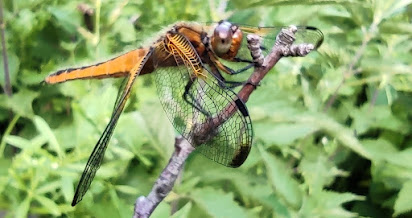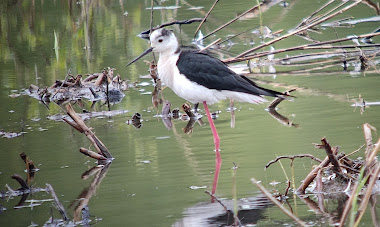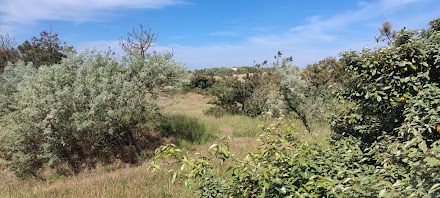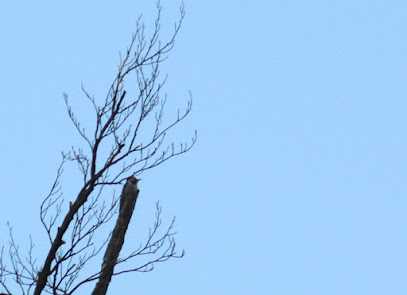Cycled up to Wheldrake to see a Spotted Redshank found by Dunc this morning at Bank Island. A smart adult, still in immaculate breeding attire and presumably a returning female on it's way south having finished breeding (the females depart first apparently). Spotshanks are just about annual in the York area and they are always a great bird to see locally. I wandered on to the ings afterwards, seeing some Red-eyed Damselflies on the pool, plus plenty of Four-spotted Chasers and Banded Demoiselles along the river. At least one Common Tern chick on the raft too along with its loafing parents.
Sunday 19 June 2022
Saturday 11 June 2022
Norfolk: Old Haunts with Old Mates
Norfolk, my much-missed former residence, was the location for a
Wildlife Travel tour led by myself and old friend, James Lowen. The trip
was all about the 'Bs', with a day in the Broads, a day in the Brecks
and a day at the Beach! James organised moth trapping including at
Weeting Heath - thanks to Joe the volunteer. This yielded a range of
fantastic moths, including many that were new to me.
The Broads
Our first day started with a moth trap led by James, in the hotel garden. About 40 species trapped, including a lovely Lime Hawkmoth and a Beautiful Golden Y.
Lime Hawk, Beautiful Golden Y and European Corn Borer
Next we headed for my old stomping ground of Hickling Broad. Swallowtails and Green-eyed Hawkers showed brilliantly, which was a relief as many of the clients were keen to see these iconic species.
On the bird front, three Spoonbills were the highlight, along with good views of dragonfly-hunting Hobbies, multiple Marsh Harriers, Little Ringed Plover, Bearded Tits etc. Three Adders were a fine bonus as were my first Variable Damselflies.
After Hickling, we had an hour at Strumpshaw Fen, close to where we used to live. A Scarce Chaser posed for the group and we got brief views of a Balsam Carpet, a pretty scarce moth.
Breckland
The moth trap at Weeting Heath was sublime, with loads of new species for me and some real Breckland specials, such as Lunar Yellow Underwing and Oblique Striped. The group marvelled at Poplar Hawkmoth, Clouded Buff and others.
Clouded Buff, Oblique Striped and Lunar Yellow UnderwingWe could have spend all morning with the moths, but the lure of Stone Curlews eventually drew us away, which we enjoyed from the hide for a while. We also had nice views of a Spotted Flycatcher near here. Time was getting on, so we headed off to a few local sites where we looked for scarce day-flying moths and some rare plants, adding Field Wormwood and Proliferous Pink to the list. We finished the day at Lakenheath Fen, reminiscing about the Golden Orioles we used to see here in the past.
The Beach
Kelling
Heath was our first destination, where we found Silver-studded Blue,
Green Hairstreak, July Belle, Woodlark, Stonechat and Red-banded Digger
Wasp amongst other heathland species. The large wasp was superb,
diligently filling in and covering up the hole it had dug to house it's
egg and prey. Class.
Green Hairstreak, Red-banded Digger Wasp, Dodder ('strawberry laces') and July Belle (courtesy of Charles Waters).
Morston Quay and a cruise to see seals was next on the agenda, although the seals were miles away on a sandbank off Warham. We did however see a Spoonbill flying over, plus a few late migrant waders and great views of Little and Sandwich Terns.
With a change to the itinerary, we decided to head to Titchwell where we delighted in dozens of Avocet chicks of various ages, Little Gulls, a range of waders and best of all a spotty Spotted Sandpiper, the first in Norfolk since the 90s! The whole group managed to get reasonable views of this little wader through the scope which was great. On the way back, one of the group found a smart Bee Orchid next to the path, a fine way to end a great trip.
Military Coup
Got a tip-off that some Military Orchids were viewable in the Brecks without having to book on a guided tour to the Suffolk WT nature reserve, which famously hosts a colony. This is an exceptionally rare species in the UK, so it was a real privelege to see these orchids. They had passed their best just slightly; apparently the flowers rapidly wither as soon as they are pollinated. Each floret is said to resemble a soldier, though the tiny figure appeared to be wearing a bonnet - not that solider-like!

The orchids were growing in a mossy former sandpit, with a lot of birch regrowth which presumably is cut each year. A number of Southern Marsh orchids were also growing here, along with Mouse-ear Hawkweed.
Stilt-uesque!
Great to spend some time watching Black-winged Stilts on Monday. The whiter-headed female spent her time hunkered down on her nest, whilst the male fed around the lagoon. A really handsome and statuesque bird, the male showed really well, preening for a period at close range. A deep amber eye was noted, along with his long, elegant black wings and needle-fine black bill.
I hope this pair manages to hatch their eggs and raise their young, without attracting the attention of predators. Families of Lapwing and Oystercatcher nearby, gave me hope of a positive outcome.
Watching these stilts reminded me of the trip I made with my Dad and John down to Holme Dunes, Norfolk, back in 1987, to see the pair that had nested. When we arrived the pair were escorting two tiny chicks around the lagoon. I am sure John would have enjoyed seeing this pair, some 35 years later. I will take my Dad once he is a bit more mobile.
Also seen, a sleepy drake Garganey, Common Tern and three well-grown Fox cubs. gambolling along the back of the lagoon.
Saturday 4 June 2022
Pas-de-Calais, France (Le Touquet, Baie De Canche and Crecy Forest)
Spent an enjoyable and relaxing half term hol just south of Calais, France at Le Touquet. I managed to fit in a bit of birding during the week and even managed a lifer - Middle Spotted Woodpecker! My birding was restricted to three sites: Le Touquet dunes and estuary, Baie de Canche and Crecy Forest.
Le Touquet is about 35 minutes south of Calais on the A16. It sits on the south side of the Canche estuary and has a fantastic dune system which have been well-protected and is a Natura 2000 site. The scrub and woodland inland of the dunes held Nightingale and Firecrest and looked great for migrants. The estuary itself was good for Spoonbills, Little and Cattle Egrets, waders and gulls, plus a few Sandwich Terns. Black Redstarts were frequently heard and seen around the town, often singing from television aerials. There were a few Swifts and Serins around but not many of either, which seemed a bit strange.
Reserve Naturelle de la Baie De Canche
This varied reserve is about 15 minutes from Le Touquet, accessed just north of Etaples (across the bridge from Le Touquet) and either side of the D940. Parking is up a side road to the west of the D940 signed for a campsite. There is a car park after about 20 metres on the right. From this car park, you can walk the blue trail, which takes you uphill through woodland and sandy heath. Our only walk was in the middle of the afternoon so it was pretty quiet, apart from a few Nightingales. The site is good for Nightjar, Woodlark, Honey Buzzard and Fen Orchid, although I suspect you would need to go off the trail to find the latter.
About 1km back towards Etaples is the red trail which is on the coastal side of the D940. This is a short trail through wet woodland and scrub and on to the coastal marshes. I was able to park on the wide road verge next to the start of the red trail which saved a long walk from the reserve car park. I had seen some local birders doing that the previous day so realised it was ok. Out on the marhes, there are many ponds with shooting butts which are heavily used during autumn and winter for duck shooting.
The fringe of the marshes had patches of sand dunes and reedbed and there were a couple of big lagoons with nice hides overlooking them. Bluethroats (white-spotted) were easy to find here and were singing early morning. One male was watched feeding a brood of stripy fledglings, hopping about on a dry muddy pool. They often skulked in the reedbeds, but occasionally would sit up on top of the Sea Buckthorn and phragmites.
Bluethroat, Nightingale, Zitting Cisticola etc singing after dawn.
I was surprised to find three Zitting Cisticolas singing on the marsh here, plus lots of Reed and Cetti's Warblers and one Sedge Warbler. Water Rails were squealing from the reedbed and the main lagoon held six Spoonbills, four White Storks and plenty of Little Egrets. Two Cattle Egrets were hanging about with the cattle that were grazing the marsh. Nightingales, Whitethroats, Lesser Whitethroats and Blackcaps were common in the scrub, and I saw a Cuckoo and a pair of Stonechats.
Cattle Egret, Lesser Whitethroat, 2 x Nightingales, Reed Warbler, White Stork.....
Crecy Forest
This large managed forest lies about 30 minutes south of Le Touquet and is easily accessed from Forest Montiers a couple of minutes off the A16. The nearest car park to Le Touquet is the one just west of the A16 at Forest Montiers on the east side of the forest (see map below - FM is on the left hand side) from where you can explore the forest. The site is managed for forestry but has some good deciduous woodland, scrubby areas and good trails. It is worth using your smartphone and googlemaps to navigate as it is big enough to get lost. We got a few ticks from our two walks, so it is worth checking yourself after a visit.
On our first visit, we arrived late morning so activity was much less than my second visit, where I arrived at 6.30am, an hour or so after first light. However, even in the middle of the day, Melodious Warblers were still singing from the Broom and Birch scrub (see pic below) and raptors were in evidence, with Common and Honey Buzzards and Hobby over the forest.
On my second visit the sun was barely up and the birdsong was magical, with several species of warblers singing, along with Nightingales and Blackbirds. The highlights of my three hour walk were a couple of Red Foxes and several Roe Deer, Short-toed Treecreepers, Nuthatches, Crested Tits, Firecrests, lots of Melodious Warblers and best of all, a Middle Spotted Woodpecker. This was a species I was particularly keen to find having failed to find them elsewhere in the past, and for the first hour I saw and heard nothing but Great Spotteds. A bird which looked a little smaller flew over my head and landed on a dead branch in the crown of a nearby tree. To my delight, it was a MSW and perched long enough for me to get a record shot. It was against the light so was quite dark, but lightening the picture helps see the key features. It flew out of the tree and didn't appear to go far but I didn't manage to relocate it. I continued my walk adding Green Woodpecker. There are apparently Black Woodpeckers here and I got a glimpse of a bird that could have been this species on my first visit, but I couldn't track it down. Other birds of note included Hawfinch, Jay, Marsh Tit and Firecrest. Wood and Icterine Warblers also occur in the forest, but I didn't find either. There was a photo of an Icky from the forest posted on ebird the week before, mislabelled as a Melodious Warbler.
Firecrest, Fox and Middle Spotted Woodpecker.
The Princess Eleonora
Last Thursday, I was amazed to hear of the arrival of an Eleonora's Falcon at Sandwich Bay in Kent. Too far for me to twitch from York but it was unlikely to linger anyway; most Eleonora's are only seen by the finder, it seems. To the delight of many, she was relocated over nearby Worth Marshes and was still present on Saturday morning as we were heading to France for a family hol. I toyed with the idea of detouring to have a look, but the heavy traffic and reports of big queues at the ports put us off and we instead spent the late morning queuing for the Channel Tunnel.
Fast forward to Thursday and I decided to check the UK bird news. Astonishingly, the falcon was still lingering at Worth. Would I get chance to see it on the way back?
Friday morning came and we cruised back to Calais to catch the train, given ourselves plenty of time to queue. As it turned out, we drove straight up to the check-in barrier and were put on an early train! This was great and with news of the falcon being still present, the twitch was on!
....
A short drive along the beautiful Kent coast and we were welcomed by a RSPB volunteer at Worth.
The Eleonora's Falcon was located immediately, crusing around lazily over the village.
She was quite different in appearance to nearby Hobbies, being bigger, longer-tailed and longer-winged. Overall very dark, with dark slate upperparts, and dark underwings, blackest on the underwing coverts. The body was buffy, with heavy black streaking, contrasting with an off-white throat and cheek. Blackish cap and moustachial stripe, dark eye and greyish cere. After catching a large dragonfly, she glided down into the fields between the village and the wood and landed atop a fencepost. I headed to the nearby barns where I watched her for a while and she noticed before I did the arrival of two Hobbies on to the same fence. She took exception to the nearest bird and chased it away. The Hobbies looked really short-tailed and dinky compared with the Princess, as can be seen in the video below.
To my delight, she took off after a rest and circled around and straight overhead, at one point seemingly staring at me (!), before heading off over the car park. I alerted Vicky and she and the kids shared great views as the falcon meandered over. I had a scan around and couldn't locate the Red-footed Falcon and as we had a long journey ahead, we decided to head off.
Big thanks to the RSPB team at Worth who had organised the parking and gave us a warm welcome.
I hope all twitchers donated generously.
















































